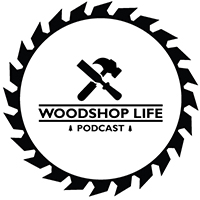This Episodes Question:
Guy’s Questions:
Why hello gentlemen. I have a crazy question for you all. I am about to build a vanity for my bathroom out of poplar. I am leaning towards staining the vanity, but I don’t know what to put on the vanity to protect it from moisture. Do you guys have any suggestions? If so, it would be very helpful.
P.S. I am always looking forward to listening to show keep up the amazing advice
Thanks, Ethan Thompson !
Hi guys!
Alissa’s question from the your last episode spurred a question if my own. Alissa asked about homemade box joint jigs and the consensus seemed to be that making your own box joint jig is more trouble than it’s worth because of the precision required (down to a few thousandths if an inch) and because of wood movement.
I was wondering if you had any thoughts on using 3d printers for jig construction. My only experience with 3d printing was about 15 years ago when we got to use a primitive 3d printer in middle school woodshop class, so I don’t really know the capabilities of 3d printers today.
Do you guys think it would be beneficial or even possible to 3d print components to homemade jigs (anything from a miter bar to a complete jig)? It seems like 3d printing would give you more precision and no movement, unlike wood.
If it is possible, What jigs do you think would lend themselves best to bring 3d printed? Andrew
After hearing Guy mention Target coatings and Emtech finishes I signed up for their email. They had a nice year-end sale and I ended up ordering their Emtech spray kit which is the Fuji LX-20 and some accessories. I’m new to spray finishing. I’m lucky enough to have a large 80 gallon 5 HP compressor, so I have plenty of air.
I’d like to know Guy’s procedure for spraying small shellac projects. I’ve heard him mention he just whips out his spray gun and it’s a quick process. Do you lay down drop cloths? Do you do anything for ventilation – I know with solvent and oil finishes you’re supposed to, but I’m wondering if you bother if it’s a small piece. Do you have a fan setup to blow overspray away? I will, of course, wear an organic filter respirator for any spray finishing I do, whether water based or not. I haven’t purchased a respirator yet, any recommendations? Scott Goldthwaite
Huy’s Questions:
Hey guys, I’ve finally got caught up on all the podcasts and look forward to hearing the next one. I have a multiple part question here. I just got a commission on a 12 foot walnut bar and matching 8-10 foot table. My next purchase is going to be a jointer and I was wondering if a 74 or 76 inch bed jointer will be long enough or if I should just cut with my tracksaw and build a shooting board and joint everything with a hand plane? Also what would you use to dye and finish? Do you use pore filler to get a glass smooth surface or just let the finish take care of everything? Arntz Construction
Hello guys, I found your podcast a couple months ago and I’m hooked and really enjoy all the knowledge you share. I appreciate you guys taking your time to produce the podcast. My question is for my Rikon Benchtop Radial Drill Press (Model 30-140). I purchased this drill press a couple of years ago but have rarely used it mostly because of time constraints. But when I do use it, I have an issue with chuck runout. I’ve spent more time working on it then using it at this point. I checked the chuck spindle runout, and it is about .001 and once the chuck is installed, the chuck has .003 to .005 runout, with a new Fisch drill bit installed the runout on the drill bit shank varies .005 to .007 runout. Given the runout I have, I can’t get a decent hole when drilling anything. I’ve followed the instructions closely and cleaned all grease from the spindle and chuck and have reinstalled several times. I’ve tried several techniques of tightening the bit in the chuck which changed nothing. Is this a problem that is common, and do you have a recommendation to fix it, or can you recommend a better chuck? I’m considering purchasing a Grizzley Keyless chuck. Or should I sell this drill press and purchase a different one that would meet the needs of woodworking better? Thank you for your advice and keep up the great job on the podcast. Daniel Held, Fort Colllins, CO
Hey fellas. A buddy of mine asked me to replace some bad fence slats on his driveway gate. The boards are 1/2″ thick tongue and groove and look a lot like pine to me. I have a couple questions. First, do you think it’s safe to use pine to get the best match with the existing boards, or should I just go with redwood and hope that it blends in when the entire fence is restained? This gate is in Los Angeles, so we don’t get much moisture. My second question is regarding the design of the tongue and groove. They have a sharp “v” profile and don’t look like anything I’ve ever seen in the big box stores. (Photo attached). Have you guys seen this type of profile on a board before? Where would you recommend I try to source these replacement boards from? And do you have any recommendations for how I might go about milling up my own stock if I cannot find a match here in town. Thanks for all your advice. Matt Miller
